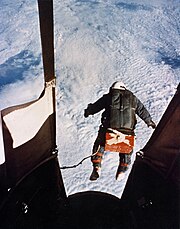August 19, 2007
You. People. Are. Crazy.
Talking about New Yorker articles that aren't online is a cruel tease, for sure. But the intro to Burkhard Bilger's piece from last week on extreme skydivers—that is to say, people who hop into giant balloons, float twenty miles up into the atmosphere, and then hop out—is too good not to quote:

Somewhere around sixty-three thousand feet above the earth, our body fluids begin to boil. They do this not because the temperature is so high but because the atmosphere is so thin. Water, kept liquid by air pressure on earth, turns to gas as the pressure drops, bubbling noticeably on the tip of the tongue. Physiologists call this altitude Armstrong's Line, after the Army Air Corps doctor who defined it, in the nineteen-thirties, and it may be the greatest barrier to our survival in space. But there are plenty of others.Here's a little bit more on Michel Fournier, as well as a brief bit on Joseph Kittinger, the Air Force colonel who holds the current skydiving record (102,800 feet, or about 19.4 miles). On that jump, in 1960, his right glove failed to pressurize and his hand swelled to twice his normal size. But that wasn't as bad as his first big jump (76,000 feet), when his first parachute wrapped around his neck, knocking him unconscious, his second parachuted got tangled around his body, and he was lucky the reserve chute managed to do its thing. And that wasn't as bad as what happened to the poor bloke who tried to break his record in 1966.
Above ten thousand feet, pilots without air tanks begin to suffer hypoxia: their brains get so little oxygen that they start to speak gibberish and make foolish errors. At forty thousand feet, temperatures can drop below negative sixty-five degrees Fahrenheit. At fifty thousand feet, any gases trapped in the body expand to more than eight times their volume at sea level, swelling intestines, rupturing lung tissue, and distending the abdomen until it hinders breathing. In 1959, when a Marine lieutenant colonel named William Rankin bailed out of his fighter jet at fifty thousand feet, he barely survived the fall, bleeding from every orifice. Had he stayed at that altitude without an oxygen mask, he would have blacked out within ten seconds and suffered brain damage within minutes.
Michel Fournier has fallen from thirty-nine thousand feet-he holds the French record for high-altitude skydiving-but he longs to go much higher. His record jump was just a warmup, he says, for what he calls le Grand Saut, the Great Leap: the highest, longest, and fastest jump ever attempted. Later this summer, weather and equipment permitting, Fournier will don a pressure suit, climb into a space capsule attached to a vast helium balloon, and rise twenty-five miles above the plains of Saskatchewan-more than twice the height of Armstrong's Line. Then he'll jump out.
Here's a somewhat-confusing video of Kittinger's 19-mile jump. It mostly looks like he does a lot of spinning around. So, I'll just casually mention that the Bilger piece is my favorite New Yorker piece of, like, the last four-and-a-half months, and tell everyone to go read it (or, hell, email me for a bootleg copy). Once upon a time I had a physics teacher who marveled at the fact that kids were getting high off whipped cream chargers, saying, "Ach. The human spirit is indomitable." Well said.
